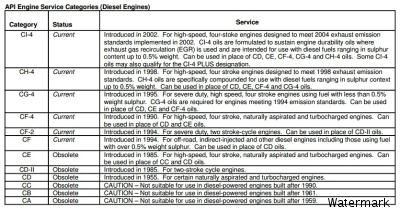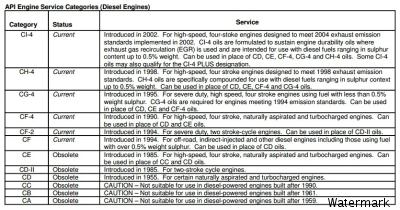LUBRICANT SERVICE CLASSIFICATIONS AND SPECIFICATIONS
API SERVICE CLASSIFICATIONS (ENGINE CRANKCASE OILS)
The American Petroleum Institute (API) Engine Service Classification was developed as a result of a co-operative effort in the USA
between the API, the American Society for Testing and Materials (ASTM) and the Society of Automotive Engineers (SAE). The tripartite
was developed to form a means of communication between the engine manufacturers and lubricants suppliers.
The system defines classes of service for both petrol and diesel engine applications as well as stipulating the accepted engine
laboratory tests.
The letter ‘S’ (Service Station Classification) is designated for spark ignition engines (petrol engines) in passenger cars and light
commercial vehicles. For compression ignition engines (diesel engines), the letter ‘C’ (Commercial Classifications) has been
designated. The following is a brief summary of the API classifications.
API Base Oil Definitions
Group I base stocks contain less than 90% saturates and/or greater than 0.03% sulphur and have viscosity index greater than or equal
to 80 and less than 120.
Group II base stocks contain greater than or equal to 90% saturates and less than or equal to 0.03% sulphur and have viscosity index
greater than or equal to 80 and less than 120.
Group III base stocks contain greater than or equal to 90% saturates and less than or equal to 0.03% sulphur and have viscosity index
greater than or equal to 120.
Group IV base stocks are polyalphaolefins (PAO).
Group V base stocks include all other base stocks not included in Group I, II, III or IV.
API Automotive Gear Lubricant Specifications
API SERVICE CLASSIFICATIONS
The most important internationally accepted system defining automotive gear oil performance characteristics is laid down by the
American petroleum institute (API).
API GL-1
Designates the type of service characteristics of automotive spiral-bevel and worm gear axles and some manually operated
transmissions operating under such mild conditions of low unit pressures and sliding velocities that a non-additive mineral oil can be
used satisfactorily. Oxidation and rust inhibitors, anti-foam additives and pour point depressants may be utilized to improve the
characteristics of lubricant for this service. Does not contain friction modifiers and extreme-pressure agents.
API GL-2
Designates the type of service characteristics of automotive-type worm gear axles operating under such conditions of load,
temperature and sliding velocities that lubricants satisfying API GL-1 service will not suffice. Products suited for this type of service
contain anti-wear or very mild extreme-pressure agents that provide protection for worm gears.
API GL-3
Designates the type of service characteristics of manual transmissions and spiral-bevel axles operating under moderately sever
conditions of speed and load. These service conditions require a lubricant having load carrying capacity greater than that which will
satisfy API GL-1 service, but below the requirements of lubricants satisfying API GL-4 service. Lubricants designated for this service
typically contain additives that are active at the tooth surface at the temperatures resulting from high-speed or load.
API GL-4
Designates the type of service characteristics of gears in manual transmissions operating under sever conditions of sliding speed,
particularly spiral bevel and hypoid gears in moderate service, in passenger cars and other automotive-type equipment operated under
high speed/low torque and low speed/high torque conditions.
API GL-5
Designates the type of service characteristics of gears particularly hypoid, in passenger cars and other automotive equipment operated
under high-speed/shock load, high-speed/low-torque, and low-speed/high-torque conditions. Equivalent to MIL-L-2105D, this category
is mainly applicable to axles but may also be used for certain manual transmissions.
API GL-6 (Obsolete)
They type of service designated by API GL-6 is characteristic of gears, specifically high offset hypoid gears in passenger cars and
other automotive equipment operated under high-speed high-performance conditions. This classification is obsolete. The equipment
required for the test procedure to verify lubricant performance is no longer available.
API MT-1
This category defines a gear lubricant for heavy-duty manual transmissions that has thermal stability, high temperature cyclic durability
and copper compatibility level exceeding API GL-1 through GL-5. Gear lubricants in this category typically meet the service
requirements of non-synchronized manual transmissions in heavy-duty trucks and in buses.API Engine Service Categories (Gasoline/Petrol Engines)
API Engine Service Categories (Gasoline/Petrol Engines)
Category
Status Service
SM Current For all automotive engines currently in use. Introduced November 30, 2004, SM oils are designed to
provide improved oxidation resistance, improved deposit protection, better wear protection, and better
low-temperature performance over the life of the oil. Some SM oils may also meet the latest ILSAC
specification and/or qualify as Energy Conserving.
SL Current For all automotive engines presently in use. Introduced July 1, 2001. SL oils are designed to provide
better high-temperature deposit control and lower oil consumption. Some of these oils may also meet
the latest ILSAC specification and/or qualify as Energy Conserving.
SJ Current For 2001 and older automotive engines.
SH Obsolete For 1996 and older engines. Valid when preceded by current C categories.
SG Obsolete For 1993 and older engines.
SF Obsolete For 1998 and older engines.
SE Obsolete CAUTION – Not suitable for use in gasoline-powered automotive engines built after 1979.
SD Obsolete CAUTION – Not suitable for use in gasoline-powered automotive engines built after 1971. Use in more
modern engines may cause unsatisfactory performance or equipment harm.
SC Obsolete CAUTION – Not suitable for use in gasoline-powered automotive engines built after 1967. Use in more
modern engines may cause unsatisfactory performance or equipment harm.
SB Obsolete CAUTION – Not suitable for use in gasoline-powered automotive engines built after 1963. Use in more
modern engines may cause unsatisfactory performance or equipment harm. Use only when specifically
recommended by the manufacturer.
SA Obsolete CAUTION – Contains no additives. Not suitable for use in gasoline-powered automotive engines built
after 1930. Use in modern engines may cause unsatisfactory engine performance or equipment harm.
Use only when specifically recommended by the manufacturer.
Note: API intentionally omitted “SI” and “SK” from the sequence of categories.
For more information about API’s Engine Oil Program, visit their website at www.api.org/eolcs.

